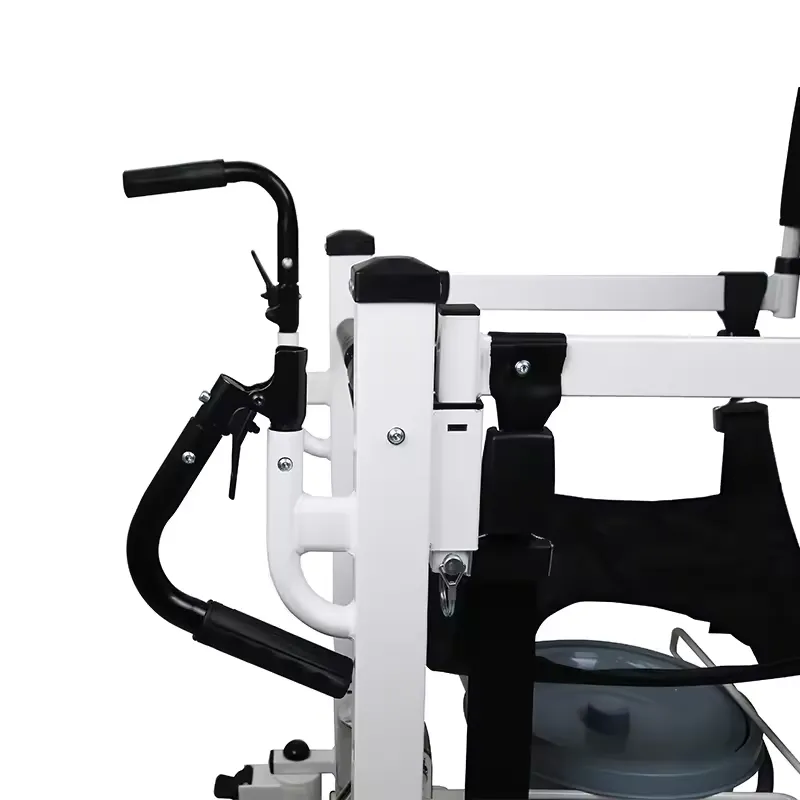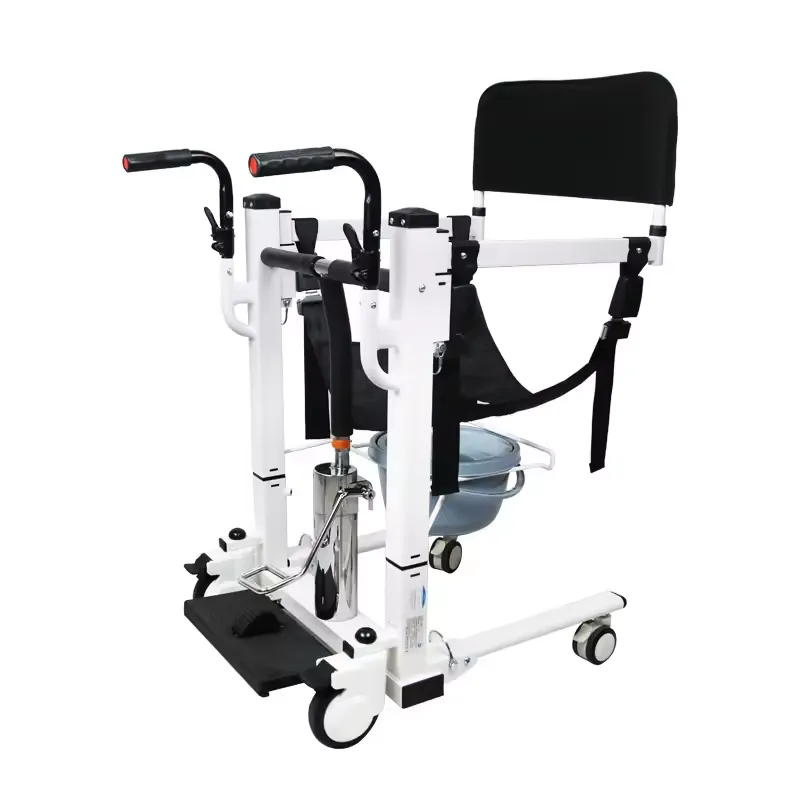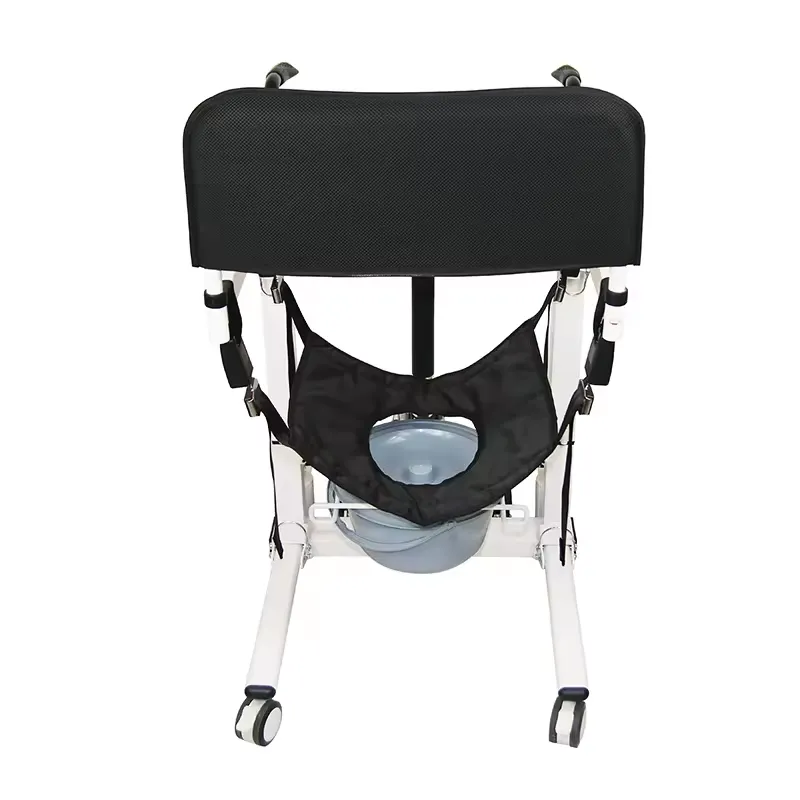In today's healthcare system, safely transferring patients from their bed to a toilet, wheelchair, or other medical area is a daily yet crucial task. A simple, safe transfer tool is particularly crucial for patients with limited mobility, bedridden patients, recovering from surgery, or the elderly.
Against this backdrop, the hydraulic lift transfer chair has emerged as an increasingly common device in hospitals, nursing homes, and home care settings.
So, what exactly is a hydraulic lift transfer chair? How does it differ from a standard wheelchair or electric nursing chair? Who is it suitable for? Why has it become indispensable in the nursing experience? This article will provide a professional and systematic explanation of these key questions.

What is a hydraulic lift transfer chair?
A hydraulic lift transfer chair is a professional nursing device that combines lifting, support, mobility, transfer, and toileting assistance. Powered by a hydraulic system, it allows for height adjustment, allowing it to accommodate beds, wheelchairs, toilets, or nursing platforms of varying heights, helping caregivers safely and non-invasively transfer patients from one location to another.
A hydraulic lift transfer chair generally features the following core components:
· Hydraulic lift system: Adjusts seat height via a foot pedal or hand pump;
· Removable seat cushion/seat panel: Some feature a toilet seat opening for toileting;
· Openable siderails/armrests: Convenient for lateral movement;
· Locking universal wheels: Allows for movement and positioning;
· Thickened backrest and seat belt: Enhances occupant safety;
· Metal frame: Stable load-bearing and secure support.
Unlike ordinary wheelchairs that simply provide mobility, hydraulic lift transfer chairs are designed specifically for transitioning between positions during transfer and nursing care, reducing care complexity and improving patient comfort.

Detailed explanation of the working principle of a hydraulic lift transfer chair
The hydraulic lift system operates based on Pascal's principle, which states that a liquid in a closed container uniformly transmits external forces in all directions.
The core of the hydraulic system in a transfer chair is:
· Hydraulic oil is injected via a hydraulic pump or foot pump;
· The piston, under pressure, moves the chair upward or downward, driving the chair body;
· A check valve controls direction, and a buffer system controls speed.
This design is more stable than electric systems in certain environments, requires no power, and operates quietly. It is suitable for a variety of settings, including hospital wards, ICUs, and nursing facilities.
Features and advantages include:
· Smooth lifting and lowering;
· No power required;
· Easy maintenance;
· Reliable structure.
Hydraulic lift transfer chair vs. other wheelchairs: What's the difference?
Many people confuse hydraulic lift transfer chairs with common electric wheelchairs, manual wheelchairs, or portable transfer chairs. The following comparison can help better understand its professional positioning:
Functional Dimensions | Hydraulic lift transfer chair | Electric wheelchair | Manual wheelchair | Portable commode/nursing chair |
| 1. Core Function | Lifting + transfer + toileting + nursing care | Independent mobility (electronically controlled) | Self-propelled or assisted | Temporary toileting, simple mobility |
| 2. Lifting Function | Hydraulic lift system | High-end models feature electric lifts | None | Minor support |
3. User Target | For patients requiring nursing assistance, disabled, or post-operative patients | For those with upper limb weakness and mobility impairments | For those with upper limb strength or mild disability | Temporary disability, difficulty using the toilet |
| 4. Self-Propelled | No, requires additional operator | Self-steering available | Can be self-propelled | No |
| 5. Travel Distance | Indoor short distances | For medium and long distances indoors and outdoors | For short to medium distances indoors and outdoors | Short distance indoors |
| 6. Load-Bearing Design | Typically supports 150–200 kg | Generally weighs 120–150 kg | Usually 100–120 kg | Mostly under 100 kg |
The above comparison shows that the hydraulic lift transfer chair's focus is not on "transportation" but on "nursing and transfer." It is positioned more like a "nursing operation platform" or "patient mobility system," solving the problem of safe transfer between bed, bathroom, shower chair, examination table, and other locations for disabled or bedridden patients.

Who is the hydraulic lift transfer chair suitable for?
The core design concept of the hydraulic lift transfer chair is to replace the need to lift and transfer patients. This type of device primarily serves the following groups of people: bedridden patients unable to move independently; those with postoperative weakness and temporary immobility; the elderly with disabilities; and those whose family caregivers are unable to carry heavy loads and transfer objects.
1. Bedridden patients unable to move independently
Such patients include those with high-level paraplegia, hemiplegia after a stroke, spinal cord injury, and muscular dystrophy. These patients are unable to stand or move with assistance and require caregivers to assist with full-body transfers.
2. Postoperative patients with extreme weakness and temporary immobility
Patients undergoing procedures such as hip replacements, fracture repairs, and heart surgery must strictly control their positional changes during the initial recovery period. A hydraulic lift transfer chair allows for precise control of the range and angle of movement.
3. Elderly and disabled patients
Some elderly people experience long-term disabilities due to muscle degeneration, osteoporosis, and poor balance, making frequent standing and turning unsuitable. Transfer chairs facilitate basic toileting and bathing transfers.
4. Nursing Scenarios Where Family Caregivers Are Unable to Carry and Transfer
For overweight patients or elderly caregivers, directly lifting the patient is a high-risk operation. A hydraulic lift transfer chair provides mechanical assistance, significantly reducing the risk of spinal injuries for caregivers.
Key Features of a Hydraulic Lift Transfer Chair
1. Lift Range and Operation
·Generally supports a 40cm to 75cm lift;
·Mostly controlled by a foot-operated hydraulic pump or manual lever;
·Equipped with a cushioning system during lowering to prevent impact injuries.
2. Removable Armrests and Seat
·Armrests can be flipped up or removed for easy lateral movement;
·The center seat can be opened for use with a bedpan or toilet;
·Some models include a strap attachment to prevent the patient from slipping.
3. Wheel and Brake Design
·Both front and rear casters feature 360° rotation with dual brake and locking systems;
·Made of non-slip and wear-resistant PU or TPR, the chair is quiet and suitable for use in hospital rooms.
4. Overall Material and Load Capacity
· The frame is typically made of high-strength carbon steel or aircraft aluminum alloy;
· The load capacity is typically 150–200 kg, with some reinforced models supporting over 250 kg;
· The outer layer is padded with a medical-grade, eco-friendly leather pad for easy cleaning and disinfection.
What is the nursing value of the hydraulic lift transfer chair?
From medical institutions to home care, the hydraulic lift transfer chair has gradually become a standard feature of the nursing system. Its multi-dimensional value cannot be ignored:
· Reduces the physical burden on caregivers, especially during extended care settings;
· Reduces the risk of falls, abrasions, and secondary injuries;
· Improves nursing efficiency and patient comfort;
· Supports basic physiological needs such as toileting and bathing, enhancing patient dignity;
· Serves as a rehabilitation training platform (sit-to-stand training) during the rehabilitation phase.
The hydraulic lift transfer chair is a vehicle for a "revolution in nursing settings"
In contemporary healthcare, "tool-based" assistive devices are significantly improving patient experience and care efficiency. Designed specifically for transport and safety, the hydraulic lift transfer chair isn't a wheelchair replacement, but rather an integral part of the clinical care process.
It not only improves patients' living conditions but also fundamentally frees caregivers' hands, making it a must-have for future home and in-hospital care.
What competitive advantages do your commodes and shower chairs offer?
Dayang Medical manufactures ergonomic commodes and sturdy shower chairs with user safety, comfort, and hygiene in mind. Manufactured under ISO9001/ISO13485 controls in Foshan, they are FDA, TUV, and CE approved.
As a low-cost factory supplier, we provide wholesale pricing, bulk discounts, and OEM customization. If you're seeking affordable, high-quality bathing and commode aids, we can instantly supply quotes with tailored branding and quantity-based promotional pricing.










